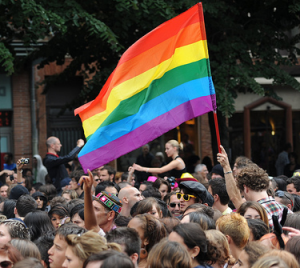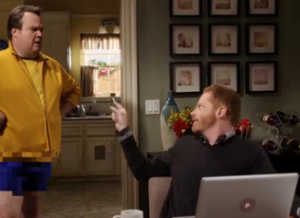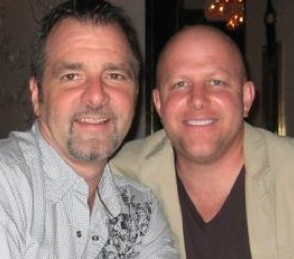Why Does Support for Gay Marriage Continue to Rise?
 Support for gay marriage has increased considerably over the last 15 years and even more rapidly over the last three years as a result of a combination of the following three things: passage of anti-gay marriage legislation, increasingly accurate media portrayals of gay Americans and by virtue of more people intimately knowing someone who is gay.
Support for gay marriage has increased considerably over the last 15 years and even more rapidly over the last three years as a result of a combination of the following three things: passage of anti-gay marriage legislation, increasingly accurate media portrayals of gay Americans and by virtue of more people intimately knowing someone who is gay.
A national Pew Research poll released on Feb. 7 found that the American public was evenly divided regarding same-sex marriage for the first time in the 15 years of polling on the issue.The study, which aggregated multiple 2011 polls, found 46 percent of Americans in support of gay marriage, whereas 45 percent opposed the institution.
Just two years prior, in 2009, an average of multiple polls found a clear majority (54 percent) opposed to gay marriage, with just 37 percent in support. When the polling began in 1996, 65 percent opposed gay marriage, while just 27 percent said they supported it.
An analysis of the polls revealed that support for gay marriage increased 10 percent over the 14 years from 1995 to 2009, but managed to increase nearly the same amount (9 percent) from 2009 to 2011.
Anti-Gay Marriage Legislation Energized Gay Community:
Casey Robinsons, 34, who has been engaged to his partner Jaron Kie for the last year, argued that Proposition 8 ironically helped the marriage equality movement.
“I think the passage of Prop. 8, in the long run, will actually be one the best moments in LGBT history.”
Although as Robinson noted, the 2008 passage of California’s Proposition 8 eliminated the marriage rights of tens of thousands of people, it effectively energized the gay rights community.
“The LGBT community, especially the gays in the LGBT community had become extremely complacent,” said Robinson. “They just figured over time they would get everything or it didn’t even bother them.
He added, “there was a resurgence of activism post-Prop. 8.”
Wade Young, 45, a West Hollywood resident who has been in a domestic partnership with Mike Rizzo, 52, since 2006, agreed.
“I think that a lot of the opposition to marriage equality is actually doing more to push the issue further,” said Young.
Young recounted his experience campaigning against Proposition 22 in 2000. Like Prop 8, which came eight years later, the initiative aimed to prevent gay marriage from occurring in the state of California.
“I remember going to even this very park (West Hollywood Park) to gay pride rallies around Southern California, trying to drum up support and get financial backing to defeat the initiative, and we couldn’t even get people in the gay community to understand what the importance of this issue was,” said Young.
According to Young, gay marriage advocates were even afraid to use the word “marriage” at the time.
“So as the National Organization for Marriage and all these what I consider (to be) hate groups have been trying to ensure that marriage equality doesn’t happen, I think that they’ve actually done more than even the gay community’s been able to do in creating the dialogue,” said Young.
“It’s pushing a whole level of people that would never become activists,” said Robinson. “If they never became activists, we probably would have stalled. We probably would not have gotten where we are today, like pushing for the end of ‘Don’t Ask, Don’t Tell.’”
The timing of Proposition 8 was also extremely important.
“The fact that the timing happened on the very night that Barack Obama, a very progressive candidate and leader in our country, was elected, (it) really shook up the progressive movement in the country,” said Young.
“Without the court battles that have been going on for the last three years, I’m not really sure that the state of Washington or New York or Washington D.C… would have moved as quickly if it hadn’t been for this national dialogue that got started with Proposition 8,” he said.
More Realistic Media Portrayals:
 On “Modern Family,” Mitchell and Cameron raise an adopted baby together.
On “Modern Family,” Mitchell and Cameron raise an adopted baby together.
Robinson, Robinson’s fiancé Kie and Young also cited the changing coverage of gay people in the American media as another reason for the increasing support for gay marriage.
“It’s a combination of both, more portrayals, but also more accurate portrayals,” said Robinson. “I don’t think anything’s more accurate than ‘Modern Family.’”
“It’s just two average-looking guys, not looking like models, not prissy queens either, who have a kid and it’s just everyday life, and the only difference between them and another couple is they happen to be two guys.”
According to Robinson’s fiancé, media portrayals of gay people were very important for his personal development growing up.
Kie, who grew up in a “very rural” New Mexico town of fewer than 8,000 people, was the only openly gay student in his high school.
“Growing up in that kind of setting, media portrayals of gay and lesbian people were very important because…I didn’t know who I was (or) what was going on,” said Kie. “I watched ‘The Real World: New Orleans.’ Danny, who came out, had a boyfriend in the military… so that was very interesting to see that.”
Kie also cited “Will & Grace” as a more recent example of realistic media portrayals of gay people.
“When I was a kid there weren’t really (gay) characters on TV except an occasional character who it was maybe even hinted (that he/she was gay) and even if it was, you never saw who they were dating,” said Robinson. “You never really saw any of it.”
“And it was always for comic relief. They were never serious actors.”
This lack of realistic media portrayals affected Robinson as a young teen.
“I found it really tough accepting who I was, not because I ever had any problem being gay,” said Robinson. “I just never had any connection to the gay community, because the only people I saw were stereotypes. Here I am a punk rocker (and) I love sports,” two qualities that had not been present in stereotypically gay characters on TV or in movies.
“Over the years, in the last decades and over the last century, there was obviously a lot of media that was very anti-gay, and it was allowed because people who were gay were not willing to stand up and perhaps rightfully lacked the courage for fear of their own lives to stand up and say ‘that’s not true. That’s not what I’m about,’” said Young.
“As people like Ellen DeGeneres, Rosie O’Donnell, Martina Navratilova (and) Greg Louganis…began to step forward and come out of the closet, then (the) media began to realize that they had a responsibility.”
Young also referenced the current TV show “Glee” and the 2008 movie “Milk” as recent examples of realistic media portrayals.
“So I do think (the media) played a significant role over the past decade in helping people to understand a little more about what being gay is versus what it’s always been perceived to be,” said Young.
“The gay teen is three times more likely to commit suicide (but) when I was a teen 20 years ago, a teen was five times more likely to commit suicide,” said Robinson.
“The three times number is not good, but it’s certainly better than it was and part of that is acceptance and that does help with accurate portrayals.”
The Personal Factor:
 In addition, an increasing number of Americans have been moved to support gay marriage by learning that a friend or close family member was gay.
In addition, an increasing number of Americans have been moved to support gay marriage by learning that a friend or close family member was gay.
“My dad is actually very conservative,” said Young.
“However, where it comes to gay rights and even gay marriage, he is very supportive and has become supportive because of the fact that he has a gay son.
“I don’t know that he would be where he’s at on this if it weren’t for the fact that I came out to him in 1995, and it really forced him and a number of other people in my family to really stop and have to rethink everything they thought they knew about gays.”
Similarly, Kie’s family’s views on gay marriage have evolved over the years.
“Their opinion of marriage at the time I came out…when I was 13, it wasn’t as well received over the years,” said Kie. “The attitude of my immediate family started to change.”
Simple exposure to gay relatives does not always lead to increasing support for gay marriage among straight individuals, especially if the relatives are further removed (both geographically and on the family tree).
“Some of my extended family have not been so warm and welcome, and I actually lost a lot of family members, because they don’t agree (with) what I am or my relationship status,” said Kie.
Even so, more immediate family members such as Kie’s grandmother, have become increasingly supportive of gay marriage.
“We stayed at my grandmother’s house when Casey and I took a trip to New Mexico once, and they were very open and accepting to him,” said Kie.
Young noted the risk “the far right fringe of the Republican Party, which has really taken over the Republican Party’s platform in the last decade,” is taking by putting social issues, such as gay marriage, near the top of its agenda.
“It’s interesting that they believe that by bringing this issue to the forefront that they only risk alienating the gay community, because our community has so much reach with people who love us and care about us,” said Young.
“I think that they’re wildly underestimating the level of support and understanding that’s developing around this, because if let’s say 7 percent is gay (an arbitrary number Young used to make his point), they can look to that 7 percent and say we don’t really care if they vote for us or not, but they’re forgetting that those people, people like me, have mothers and fathers.”
Young still has two grandmothers in their 90s, one of whom he assured would “never vote for somebody who was going to amend the Constitution against her grandson.”
Young also has two voting-age children of his own (20 and 24 years old), both of whom have gay best friends. One of Young’s sons has a girlfriend, who is also very supportive of gay marriage.
“As time goes by, people start to realize that there’s not many differences between what many of us want in life,” said Kie. “So as people are more open to hearing our stories about how our lives are being affected by this, their minds are being changed by what we have to say.”
“It’s easing its way into acceptance for any number of reasons,” said Robinson. “People see errors in their ways, but it’s also a complete generational thing.”
“If you look at the polls generationally, the biggest resistance are in males over the age of 50.
“In 40 years, most of them are not going to be around.”
Robinson’s brother, who is 13 years younger, went to high school with kids who were transsexual, and according to Robinson, “it was just no big issue.”
What’s Next?
In February, the state Senate of Washington, Maryland and New Jersey each voted to legalize same-sex marriage. New Jersey Gov. Chris Christie vetoed the bill, but the bill was signed into law in Washington and Maryland.
“It would really be great to see in this next election that people, that fair-minded Americans are standing up to this kind of divisiveness and say(ing), ‘You know what. I may not agree with two guys getting married or two girls getting married, but I really disagree with government being involved in this or the majority having this kind of say in the private lives of individuals,” said Young.
“It would be great to see people stand up.”
Originally published by Neon Tommy


